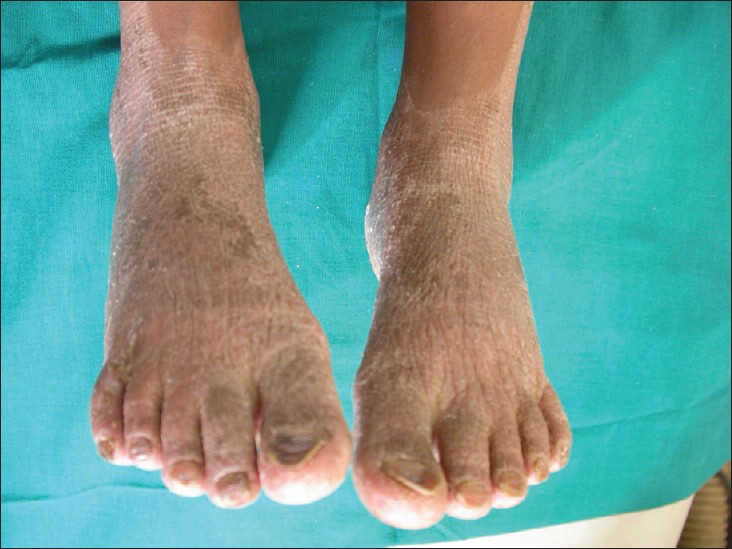|
 
 |
|
LETTER TO THE EDITOR |
|
|
|
| Year : 2011 | Volume
: 17
| Issue : 3 | Page : 245-246 |
| |
Hay-Wells syndrome of ectodermal dysplasia: A rare autosomal dominant disorder
NB Nagaveni1, KV Umashankara2
1 Department of Pedodontics and Preventive Dentistry, College of Dental Sciences, Davangere, Karnataka, India
2 Department of Oral and Maxillofacial Surgery, College of Dental Sciences, Davangere, Karnataka, India
| Date of Web Publication | 20-Jan-2012 |
Correspondence Address:
N B Nagaveni
Department of Pedodontics and Preventive Dentistry, College of Dental Sciences, Davangere, Karnataka
India
 Source of Support: None, Conflict of Interest: None
DOI: 10.4103/0971-6866.92084

How to cite this article:
Nagaveni N B, Umashankara K V. Hay-Wells syndrome of ectodermal dysplasia: A rare autosomal dominant disorder. Indian J Hum Genet 2011;17:245-6 |
How to cite this URL:
Nagaveni N B, Umashankara K V. Hay-Wells syndrome of ectodermal dysplasia: A rare autosomal dominant disorder. Indian J Hum Genet [serial online] 2011 [cited 2016 May 13];17:245-6. Available from: http://www.ijhg.com/text.asp?2011/17/3/245/92084 |
Sir,
We herein present a case of Hay-Wells syndrome (OMIM 106260), a rare genetic disorder. A 14-year-old female child was brought with complaint of missing teeth. The patient was born at term via normal vaginal delivery after an uncomplicated prenatal course. Family history revealed consanguineous marriage of parents. On physical examination, skin lesions were noticed all over the body and were more pronounced over the anterior aspect of legs [Figure 1]. The lesions were present since birth. They were hyperkeratotic, dry and scaly. Fissuring and thickening of the skin over soles was also observed. There was no history of discharge of pus or fluid from the skin lesions. During winter, the lesions over the soles bleed. Patient also had depressed nasal bride, sparse scalp hair, dysplastic nails [Figure 2] and decreased sweating. Past medical history revealed the presence of cleft lip which was later surgically corrected. On intraoral examination, missing of multiple permanent teeth was noticed which was confirmed on radiographic examination.  | Figure 2: Dry and scaly skin lesions on dorsal surface of feet with dystrophic nails
Click here to view |
Hay-Wells syndrome is a form of ectodermal dysplasia, a group of over 100 inherited disorders that cause hair, teeth, nails, and glands to develop abnormally. It was first described by Hay and Wells in 1976, [1] also known as 'ankyloblepharon-ectodermal dysplasia-clefting syndrome' (AEC) and inherited in an autosomal dominant pattern. [2]
This syndrome affects both males and females of all ethnic backgrounds. It is not known exactly how often it occurs. The major symptoms include palmoplantar hyperkeratosis, sparse, coarse, wiry hair, small, sparse eyelashes, malformed nails, missing teeth (anodontia/oligodontia), cleft palate, sometimes with cleft lip and lid adhesions/ankyloblepharon. [1],[2] Other features are broad nose, decreased sweating. Since Hay-Wells syndrome is present from birth, diagnosis is based on the physical appearance of an infant or young child. In some cases, the syndrome is not apparent until the teeth fail to develop normally. [1]
Differential diagnosis includes ectrodactyly-ectodermal dysplasia-cleft lip/palate (EEC) syndrome, limb-mammary syndrome (LMS), acro-dermato-unguallacrimal-tooth syndrome (ADULT). [1],[2] Heterozygous missense mutation in the SAM domain of p63 gene, which is required for craniofacial and limb development, is suggested as a likely gene accounting for AEC phenotype. [2],[3]
As this syndrome is an inherited genetic disorder, treatment focuses on the symptoms present. Bacitracin ointment and mupirocin 2% ointment for skin lesions is required. [4] Surgery can be done to correct cleft lip and palate. Speech therapy may be necessary because of cleft palate and/or missing teeth. Genetic counseling will be helpful for the individual and family affected by Hay-Wells syndrome.
 References References | |  |
| 1. | Hay RJ, Wells RS. The syndrome of ankyloblepharon, ectodermal defects and cleft lip and palate: An autosomal dominant condition. Br J Dermatol 1976;94:287-9. 
|
| 2. | McGrath JA, Duijf PH, Doetsch V, Irvine AD, de Waal R, Vanmolkot KR, et al. Hay-Wells syndrome is caused by heterozygous missense mutations in the SAM domain of p63. Hum Mole Genet 2001;10:221-9. 
|
| 3. | Fomenkov A, Huang YP, Topaloglu O, Brechman A, Osada M, Fomenkova T, et al. P63 alpha mutations lead to aberrant splicing of keratinocyte growth factor receptor in the Hay-Wells syndrome. J Biol Chem 2003;278:23906-14. 
[PUBMED] [FULLTEXT] |
| 4. | Mancini AJ, Paller AS. What syndrome is this? Ankyloblepharon-ectodermal defects-cleft lip and palate (Hay-Wells) syndrome. Pediatr Dermatol 1997;14:403. 
[PUBMED] |
[Figure 1], [Figure 2]
|






